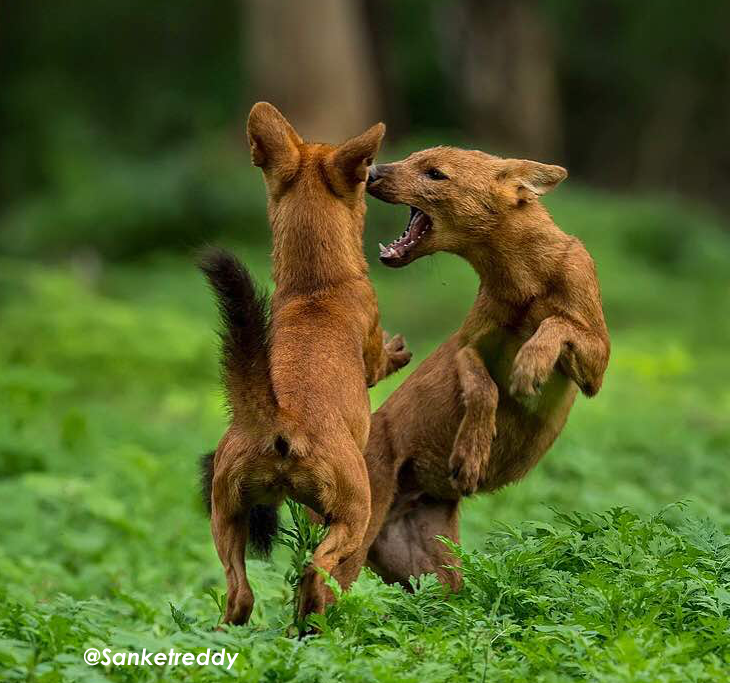Startups, Mimic Wild dogs, not lions. Business lessons from Wild Dogs (#8)

This article talks bout business lessons from wild dogs, part of series of articles about business lessons from Wild Animals.
In big corporates, everyone wants to emulate a Lion and it’s supremacy and the way they hunt their prey, and why not, after all it is called the King of the Jungle (no disrespect to my dear friend, the Tiger, who I believe is the “real king” of the jungle and more of it in a different blog) and it is depicted like that. But did you know that their success rate [hunt to kill ratio] is just 20 to 30%?
Also among lions, once a kill is made, the dominant lion will feed first after chasing the other lions away. He will be followed by the females and then the cubs. This keeps the strongest strong and the weak, the cubs, will often starve. This happens in our corporate teams too – the leader gets the lion share be it compensation or credits while the others who “really” worked are pushed to the sidelines – happens all the time right? We can all say, this happens in the Lion world too – what’s the big deal – we humans are just following what the “king of the jungle” does!!
We have seen this in our cricket too, it always rotates around two or max three “big” guys and all the compensation, credits and ads go to them and others just rotate around them even though its a team work that won the game. Also when the big guys fail, the team flops because we know that even lion’s success rate is just 20 to 30%.
When you are a startup or if you are a SME, you cannot survive if you hunt like a lion or follow lion tactics and work ethics but you need to follow a different beast and its work (or hunt) ethics. It’s not-so-popular-species but it has a ‘hunt to kill’ ratio of more than 80%!!! 2.5 times of a Lion and they are probably 1/3rd or 1/4th the size of a Lion. Generally they don’t have a celebrity hero as the leader but still they achieve their success. How? Unlike Lions and other big cat predators these can hunt very large prey relative to their body size. How come?
Come let’s learn who are they and how do they achieve it, and in the process lets learn business lessons from them on how to achieve such a high success rate even if you are not a big company, even if you not a big brand.
Business lessons from Wild Dogs
Yes they are wild dogs – they are called African Wild Dogs over there and here in India we call them Dholes!! Yes they are of the size of your pet dog or even smaller than that but they can even scare an Elephant!! No kidding.
They are a great example of how teamwork contributes to the strength & eventual success of the group and provide a salutary lesson for businesses. They will hunt large prey relative to their body size and have an amazing success rate of 80%. The reason they achieve a successful hunt is because they work as a team to overcome their size deficiency and the success of the team goes way beyond the sum of their parts.
How they do?
The reason for this huge success ratio is the teamwork. These animals hunt with a common objective and shared leadership. In tracking their prey, they follow a line, where when the front dog gets tired, they drop to the back of the line to rest. This is done on need, rather than through any hierarchy structure. Once on the attack, the dogs fan out. Whichever dog is in the strongest position leads the hunt. It may be the fastest dog or just the one in the right position. If the prey turns right, one of the dogs on the right takes the lead and so on. This way, the strongest dog at any particular time is always on the attack.
Because the Wild Dog pack have a shared vision of how the pack survives, the cubs always eat first ensuring that they grow to strengthen the pack. Sometimes the dominant mother will eat first only so she can regurgitate food to the younger cubs. One other trait of the Wild Dog is their tenacity, which contributes to their success. The can hunt prey over 2-3 days without rest
Everyone in the team pulls together and when one is down or tired other takes over and no one says “it’s not my job’. Everyone pitches in where required. Whoever is in the best position to do the job, gets on with it.
Lessons to learn:
When you are a SME or a Startup, your size/power all are equivalent to a Dhole in the Wild. You can only survive and grow and with a huge success rate only if you do work and strategize like Dholes. You team leader, team members and your strategy should mimic Dholes way of team dynamics – everyone are picked based on their skill and selflessness, none in the team trying to be a celebrity, none in the team is more important than the other, there is no single leader, everyone takes leadership role when required, helping each other rather than competing with each other, ideally no management hierarchy between them and last but definitely not least, no one ever utters or follows the cardinal sin – “‘it’s not my job’.
[Wild dogs can be seen in Nagarhole, Bandipur, Kabini, Bhadra, Ranthambore, Kanha, Tadoba, Bandhavgarh and many national parks across India]
Further Reads:
When to inject venom and when not to? Let’s learn a business lesson from Snakes (#5)
How mongoose attacks a snake, a business lesson is hidden inside, lesson #3
How to price your product? let’s learn a business lesson from Paper Wasps (#4)
Nature or Nurture? A business lesson from Dunnock Birds (#6)
Mother Giraffe kicks their newborn & Why? Business lessons from our Wildlife, #2
Business lessons from our Wildlife – Lesson #1 – Baya Weaver Bird
Cigarette Butts & Building Nests, Business lesson from House Finches (#7)
WildTrails (Tm) India App – “Discover Indian Wildlife Like Never Before“
PS: Please be a responsible wildlife tourist; No littering, No sounds, No feeding, no getting down from the safari jeep (when on safari), No phone calls. Remember that we are visiting their home and when we are there, let’s follow their rules.
[The WildTrails India App is the best way to get all the details about Indian wildlife sanctuaries (best travel times, safari details, animal sightings, forest accommodations pairing, wildlife related activities, prices, etc). Learn more about WildTrails of India here. ios App is here. Android is here, and Web is on the way. Please do like us on our facebook page here.]
With 4 years of Sightings data + Extensive expert tracker network in jungles, our customers had the best wildlife experiences.
Buy Wildlife Fashion Accessories
Exclusive Online Store for wildlife products
Packages
Packages Loading...
Recent Posts







